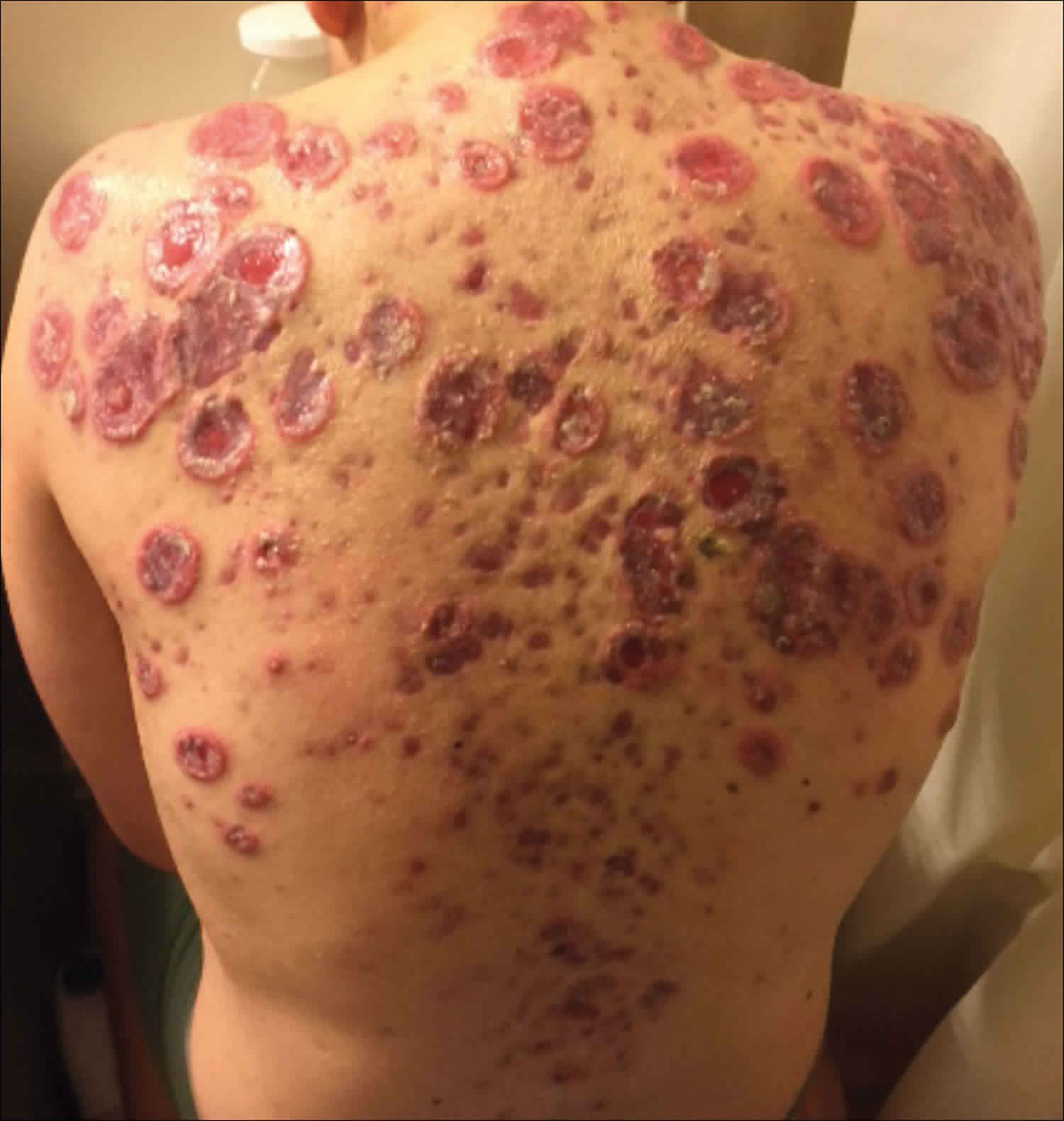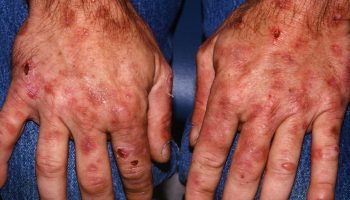What is acne fulminans
Acne fulminans also called acne maligna is an extremely rare skin disorder and very severe form of acne conglobata (severe nodulocystic acne) associated with systemic symptoms. Less than 200 cases are known 1. Acne fulminans presents as an acute, painful, ulcerating, and hemorrhagic clinical form of acne. It may or may not be associated with systemic symptoms such as fever and polyarthritis. Acne fulminans also may cause bone lesions and laboratory abnormalities. Acne fulminans often is confused with acne conglobata. Acne fulminans nearly always affects adolescent males, mainly Caucasian, between 13 and 22 years of age. Most of these males have a prior history of acne. There also are isolated reports of acne fulminans in females. Acne fulminans has been reported globally, but its incidence seems to be declining. Acne fulminans usually is resistant to the usual acne antibiotics 1.
Patients with acne fulminans should consult a dermatologist urgently. Management can prove difficult, and several medications are usually required for several months or longer. These may include:
- Systemic corticosteroids such as prednisone (20–60 mg/day)
- Anti-inflammatory medications such as salicylates (aspirin)
- Dapsone 50–100 mg/d
- Ciclosporin
- High doses of oral antibiotics such as erythromycin (2 g/day) for secondary infection
- Isotretinoin commenced in low dose after control has been obtained with systemic steroids
- Tumor necrosis factor-alpha (TNF-α) inhibitors, such as infliximab.
Topical acne medications are unhelpful.
Figure 1. Acne fulminans face
Footnote: (a)Left side of the face at the time of presentation (b) Left side of the face at 1 month post adalimumab therapy.
[Source 2 ]Acne fulminans causes
Acne fulminans is a rare skin disorder, and hence its cause is not well understood.
Acne fulminans has been associated with increased androgens (male hormones), autoimmune complex disease and genetic predisposition. It may be related to an explosive hypersensitivity reaction to surface bacteria (Cutibacteria acnes). Acne fulminans may be precipitated by:
- Testosterone and anabolic steroids (legally prescribed or illegally taken to enhance muscle growth)
- Oral isotretinoin.
Acne fulminans may be triggered by the use of high doses of isotretinoin when initiating treatment in patients with severe acne 1. Also, elevated levels testosterone may have a role in the pathogenesis 1. Anabolic steroids are known to increase levels of sebum and density of Propionibacterium acnes. Bodybuilders who use anabolic steroids develop acne fulminans within a very short time. It is believed that the density of P. acnes or related antigens trigger the immune system and lead to acne fulminans. There are others who believe the condition to be autoimmune mediated because circulating immune complexes have been observed in some patients with acne fulminans 3.
Acne fulminans also has a genetic component, but the pattern of inheritance is not known. The skin disorder may be part of the synovitis, acne, pustulosis, hyperostosis, and osteitis syndrome (SAPHO), pyogenic arthritis, pyoderma gangrenosum, and acne syndrome (PAPA), pyoderma gangrenosum, acne, and hidradenitis suppurativa syndrome (PASH), and pyogenic arthritis, pyoderma gangrenosum, acne, and hidradenitis suppurativa syndrome (PAPASH).
Acne fulminans symptoms
Acne fulminans is characterized by:
- Abrupt onset
- Inflammatory and ulcerated nodular acne on chest and back, which is painful
- Bleeding crusts over the ulcers on upper trunk
- Severe acne scarring
- Fluctuating fever
- Painful joints, including sacroiliac joints in 20% of cases, ankles, shoulders and knee joints
- Malaise (ie the patient feels unwell)
- Loss of appetite and weight loss
- Enlarged liver and spleen.
Acne fulminans usually has a very sudden onset, and the acne often is ulcerating. Patients may complain of fever and pain in multiple joints. They usually provide a history that the conventional antibiotics used for treating acne did not work. Most patients mention that they did have acne in the past.
Acne fulminans is similar to acne conglobata with numerous inflammatory nodules on the trunk. The nodules often are painful to touch, ulcerated, hemorrhagic, and covered with crusts. Unlike acne conglobata, there are cysts and acutely inflamed lesions, but there are no polyporous comedones. Painful splenomegaly and erythema nodosum may be associated with systemic symptoms.
Patients with acne fulminans who have systemic symptoms may have a stooped posture due to bone and joint pain. The inflammatory arthralgia usually affects more than one joint, typically the knees, hips, and pelvis.
Acne fulminans diagnosis
Because acne fulminans may be associated with systemic symptoms, the workup should include the following:
- Complete blood cell count (CBC); may show elevated white blood cell (WBC) count with a large percentage of neutrophils, anemia of chronic disease, and/or leukemic-type reaction
- Erythrocyte sedimentation rate (ESR) and C-reactive protein may be elevated
- Liver function test
- Human chorionic gonadotrophin (hCG) (blood or urine) in female patients
Imaging
Because of bone and joint pain, imaging frequently is done. In the early stage, x-rays will only show reactive changes. About 50% of patients will demonstrate lytic lesions on a plain x-ray, and the bone scan may show multiple areas of increased uptake. The lesions are destructive and often resemble acute osteomyelitis. Cultures of these bony lesions are often negative.
Tests typically reveal:
- Anemia (lowered hemoglobin count)
- Raised white blood cell count
- Raised erythrocyte sedimentation rate (ESR) and C-reactive protein levels
- X-rays may show osteolytic bone lesions.
Acne fulminans treatment
The recommended treatment for acne fulminans is a combination of corticosteroids and isotretinoin 1. Oral corticosteroids should be started first at high doses (0.5 to 1 mg/kg/day) for at least 2 weeks (at least 4 weeks if systemic symptoms) until lesions heal. Isotretinoin is then started. The initial dose of isotretinoin should be 0.1 mg/kg/day in association with corticosteroids for 4 weeks. If no flare is observed, the same dose of isotretinoin should be maintained for 4 more weeks, and corticosteroid doses should be gradually tapered. Increasing isotretinoin doses should then be progressed to a minimum total dose of 120 mg/kg 4.
In patients who remain adherent, relapses are rare. If a relapse does occur, a repeat cumulative dose of isotretinoin at 150 mg/kg is recommended. The treatment with isotretinoin lasts for many months as the initial dose is low.
A recent review suggests that the use of additional high-potency topical corticosteroids may result in a faster response. Once healing occurs, the lesions become smaller, less tender, and have a minimal inflammatory reaction. Scarring is common.
Acne fulminans does not respond to the traditional antibiotics used to treat the typical form of acne. Even when they are used, the response is slow and incomplete.
In the last few years, anecdotal reports have appeared after use of biologics, such as etanercept and infliximab, in patients who are resistant. The response to these agents is effective and rapid. However, it is not known if biologics will work in all patients. Several other targeted biologics also have been used to treat acne fulminans.
Other treatments
Pulsed dye laser has been used with moderate effectiveness, but adverse effects and pain remain an issue. Because the lesions are large, multiple treatments are required, and scarring and hypopigmentation are common complications.
Reports suggest that diaminodiphenyl sulfone use may help ease the symptoms of acne fulminans in patients with ulcerative colitis.
Combinations of prednisone with dapsone or cyclosporine also have been tried with success.
Finally, these patients are best managed by a dermatologist and an internist. Women of childbearing age should use great caution when using retinoids, as these agents are teratogenic. There is a registry of all patients who are prescribed retinoids. All women who are prescribed isotretinoin should avoid getting pregnant for at least one month after the drug is discontinued.
- Zito PM, Badri T. Acne Fulminans. [Updated 2018 Dec 2]. In: StatPearls [Internet]. Treasure Island (FL): StatPearls Publishing; 2019 Jan-. Available from: https://www.ncbi.nlm.nih.gov/books/NBK459326[↩][↩][↩][↩][↩]
- Dawoud NM, Elnady BM, Elkhouly T, Yosef A. Adalimumab as a successful treatment for acne fulminans and bilateral acute sacroiliitis with hip synovitis complicating isotretinoin therapy. Indian J Dermatol Venereol Leprol 2018;84:104-7[↩]
- Massa AF, Burmeister L, Bass D, Zouboulis CC. Acne Fulminans: Treatment Experience from 26 Patients. Dermatology (Basel). 2017;233(2-3):136-140.[↩]
- Walsh RK, Endicott AA, Shinkai K. Diagnosis and Treatment of Rosacea Fulminans: A Comprehensive Review. Am J Clin Dermatol. 2018 Feb;19(1):79-86[↩]






